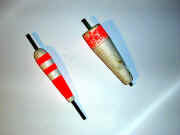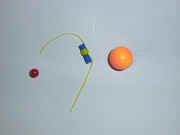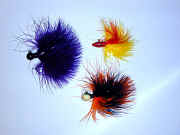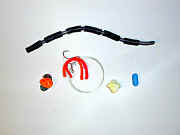Search
Latest Articles
Steelheading the Pacific Northwest
by Dave Graybill, September 01, 2003
The attention of most anglers here in North Central Washington is still on summer run and fall run salmon. Many are closely watching the dam counts for the number of steelhead that are moving upstream, in anticipation of another season for these prized fish in our region. The counts are encouraging and there is little doubt that we well see a season opening as early as October 1st.
Knowing the interest that steelhead attract to the area, I decided to give anglers some advice on how to go about catching them. I quickly scrambled through several tackle boxes, bags, drawers and scattered trays, and found some gear. You will find below some essential items that are needed for successful steelhead fishing, along with some explanation on how to rig it.
Anglers here have adopted one of the steelhead fishing systems that were developed in swift-flowing streams in Canada. The slip bobber method has been found to work just fine on even dead-slow water, and has accounted for thousands of punches on steelhead report cards.
In the photograph below, you will see two examples of the most popular slip bobbers. The difference between the two is that the one on the right is weighted. This gives an angler a bit of an edge when distance casting is required. I do want to caution anglers that there is a trade off for being able to cast long distances. The further your bobber is away from you, the more difficult it will be to control your line and hook setting much more difficult.

Steelhead Slip Bobbers
Slip bobbers allow an angler to fish different depths of water and keep their bait just off the bottom by adjusting a "bobber stop" that is tied to their main line. When rigging up for bobber fishing, the bobber stop is the first thing that goes on the line. A typical bobber stop is shown in the next photo, along with a bead and a Corky. To attach a bobber stop, run the line through the tube that is provided, like the one shown in the photo (it’s the thing with string on it). The tube is then slid off the line and the stopper knot is tightened. Do not make the knot too tight, or you will not be able to move it up and down the line. Don’t make it too loose or it will slide too easily. You’ll find the right tension after a couple of tries.
The next thing that goes on your line is the bead or Corky. The bead must be large enough to not go through the rod tip guide, and also not get stuck in the tube on your slip bobber. Some anglers prefer a small bead, while others like the Corky. A Corky often doesn’t slide down the line as easily as a bead, but it is more visible than a bead.

Steelhead Beads and Bobber Stop Knot
Once you have your bobber stop knot tied on your line, and have added a bead you can slide on your bobber. Now, what goes on the business end is usually a marabou jig. Some anglers prefer using bait only, which is usually in the form of a shrimp or roe. The marabou jig does give some attraction to the bait, though, and most jigs are used with a portion of shrimp to scent the hook. I have seen some weird baits being used by steelhead fishers here in North Central Washington. I have seen anglers take great care to dye their shrimp a variety of colors, and put a whole, large shrimp on their hook. I have seen anglers thread a large hook up through the middle of a large shrimp, so a hook point sticks out of its middle.
I don’t get it. How is a fish supposed to swallow this load? I know that some do and wind up on the bank, but an awful lot of fish are missed because of these large baits. I believe an angler is much better off using one of the jigs, such as these shown below, and add just a tail of shrimp to cover the hook. This small piece of shrimp should be coated with some kind of scent oil, too, to add to the attraction of the bait.

Steelhead Jigs
One of the features of the marabou jig is the marabou feather that "breathes" in the water. If a jig is heavily doused with scent, it will spoil the ability of the feathers to breathe. Proper use of scent, and scent is important, will allow the jig to work properly and lengthen the life of a jig.
When using a jig, be sure to sharpen the hooks. A razor sharp jig will make a huge difference. Another advantage to a jig is that the feathers will stick to a steelie’s teeth and give you an edge when they are mouthing the bait. Also look for jigs that have a fairly fine wire. These will give you better hooking ability than heavy gauge hooks.
There are a lot of different colors of jigs out there, and there is a reason. You should have a selection of colors in your box. Fish will change preference for color for reasons that aren’t clear to me, but just like fishing plugs or spoons; some days certain colors out perform others. There are a whole bunch of colors in between, but an angler should have these basic colors available to them: black, red, white, chartreuse and yellow.
Okay, you’ve got your rig all set up and baited. Now what? Remember the whole idea of this rig is to allow you to place your bait in the "zone" without hanging up. Finding the zone will take some experimentation, and will vary with every place you fish. Sometimes it’s right off bottom, and sometimes it’s mid-range in the water column. Depends on the water you are fishing and where the fish are hanging out. In fast water, the fish will most likely be hugging bottom. In still water, they may be stacked at different depths. You’ll have to play around with your depth and the slip bobber rig allows you to do this easily.
If you cast to water that is shallower than your bobber stop is set, your bobber will just lay on the surface. The bead won’t slide down to your bobber because you jig or weight is on the bottom and not dragging your line through the bobber to the bead and stopper knot.
If this is the case, simply pull your stopper knot down your line until your bobber sits up when the knot and bead get to it. You can use your fishing rod as a gauge to measure line, or your arm, or whatever. It helps to have a reference when you are looking for the right depth, and make note of it for future trips.
The set ups that I have described here have the bank angler in mind, but can also be of use to boaters. This rig is as effective when cast from shore as from a boat. I have actually caught more fish casting this rig from a boat than the shore, but it is a huge advantage to bank anglers, particularly on the Columbia River below and above the dams.
There are some refinements to the basic set up I have described here, and we may discuss these later, but for now I figured you’d just want to know what you needed to get out and get at ‘em.
I have also included in this report a few items for drifting bait. Drifting roe is a very effective way to take steelhead. Drifting isn’t limited to fishing roe, and there are occasions when anglers will use plugs and even plastic worms!
The drift set up is basically a weight system, a leader with an egg loop or shrimp hook. What I have shown in the photo below is a series of pencil leads hooked together by surgical tubing. By varying the amount of pencil lead used, the speed of the drift can be controlled, and this will always depend on the amount of current an angler is dealing with.

Steelhead Drift Rig
This "chain" of pencil lead is attached to the line with a swivel. There are some other kinds of weights designed for drifting. They each are attempting to allow an angler to present a bait without loosing their whole set up every time they cast. You’re welcome to try different kinds of weight systems, but realize that hang-ups are inevitable.
In addition to the weight and leader shown in the photo, there are a couple of bobbers. Anglers use a variety of these to add attraction to the bait, as well as lift the bait slightly off bottom. The current will drive the bait right down to the deck, and by adding some of these winged bobbers, Corkys or other drifting floats, the bait can be kept up a bit. This also helps prevent a lot of snags.



